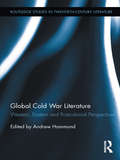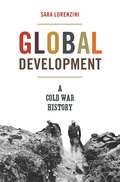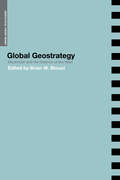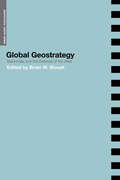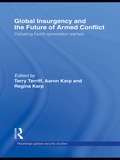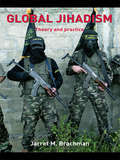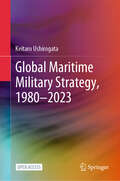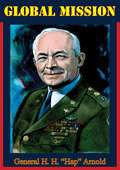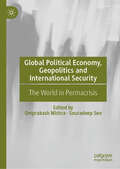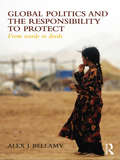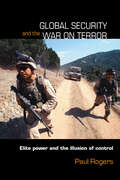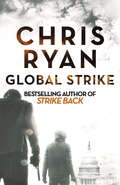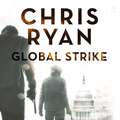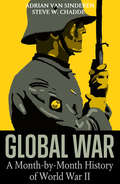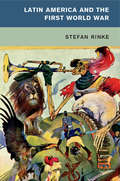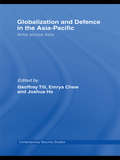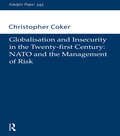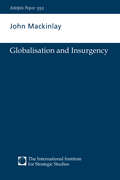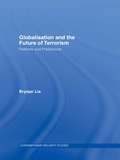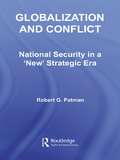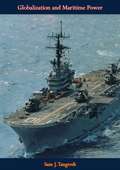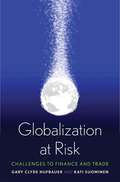- Table View
- List View
Global Cold War Literature: Western, Eastern and Postcolonial Perspectives (Routledge Studies in Twentieth-Century Literature #Vol. 3)
by Andrew HammondIn countries worldwide, the Cold War dominated politics, society and culture during the second half of the twentieth century. Global Cold War Literatures offers a unique look at the multiple ways in which writers from Asia, Africa, Europe and North and South America addressed the military conflicts, revolutions, propaganda wars and ideological debates of the era. While including essays on western European and North American literature, the volume views First World writing, not as central to the period, but as part of an international discussion of Cold War realities in which the most interesting contributions often came from marginal or subordinate cultures. To this end, there is an emphasis on the literatures of the Second and Third Worlds, including essays on Latin American poetry, Soviet travel writing, Chinese autobiography, African theatre, North Korean literature, Cuban and eastern European fiction, and Middle Eastern fiction and poetry. With the post-Cold War era still in a condition of emergence, it is essential that we look back to the 1945-89 period to understand the political and cultural forces that shaped the modern world. The volume’s analysis of those forces and its focus on many of the ‘hot spots’ – Afghanistan, Iran, North Korea – that define the contemporary ‘war on terror’, make this an essential resources for those working in Postcolonial, American and English Literatures, as well as in History, Comparative Literature, European Studies and Cultural Studies. Global Cold War Literatures is a suitable companion volume to Hammond's Cold War Literature: Writing the Global Conflict, also available from Routledge.
Global Development: A Cold War History (America in the World #38)
by Sara LorenziniIn the Cold War, "development" was a catchphrase that came to signify progress, modernity, and economic growth. Development aid was closely aligned with the security concerns of the great powers, for whom infrastructure and development projects were ideological tools for conquering hearts and minds around the globe, from Europe and Africa to Asia and Latin America. In this sweeping and incisive book, Sara Lorenzini provides a global history of development, drawing on a wealth of archival evidence to offer a panoramic and multifaceted portrait of a Cold War phenomenon that transformed the modern world.Taking readers from the aftermath of the Second World War to the tearing down of the Berlin Wall, Lorenzini shows how development projects altered local realities, transnational interactions, and even ideas about development itself. She shines new light on the international organizations behind these projects—examining their strategies and priorities and assessing the actual results on the ground—and she also gives voice to the recipients of development aid. Lorenzini shows how the Cold War shaped the global ambitions of development on both sides of the Iron Curtain, and how international organizations promoted an unrealistically harmonious vision of development that did not reflect local and international differences.An unparalleled journey into the political, intellectual, and economic history of the twentieth century, this book presents a global perspective on Cold War development, demonstrating how its impacts are still being felt today.
Global Geostrategy: Mackinder and the Defence of the West
by Brian W. BlouetThis is a new examination of Halford Mackinder’s seminal global geostrategic work, from the perspective of geography, diplomatic history, political science, international relations, imperial history, and the space age.Mackinder was a man ahead of his time. He foresaw many of the key strategic issues that came to dominate the twentieth century. Until the disintegration of the Soviet Union, western defence strategists feared that one power, or alliance, might come to dominate Eurasia. Admiral Mahan discussed this issue in The Problem of Asia (1900) but Mackinder made the most authoritative statement in "The Geographical Pivot of History" (1904). He argued that in the "closed Heart-Land of Euroasia" was a strategically placed region, with great resources, that if controlled by one force could be the basis of a World Empire. James Kurth, in Foreign Affairs, has commented that it has taken two World Wars and the Cold War to prevent Mackinder’s prophecy becoming reality. In World War I and World War II Germany achieved huge territorial gains at the expense of the Russian empire and the Soviet Union. In the former conflict the Russian empire was defeated by Germany but the western powers insisted that the territorial gains made by Germany, at the treaty of Brest-Litovsk, be given up. In World War II Britain and the US gave material support to Stalin’s totalitarian regime to prevent Nazi Germany gaining control of the territory and resources that might have been a basis for world domination. The west, highly conscious of Mackinder’s dictum (1919) that "Who rules East Europe commands the Heartland," quickly adopted policies to contain the Soviet Union. History has therefore proved Mackinder’s work to be of vital importance to generations of strategic thinking and he remains a key influence in the new millennium.This book will be of great interest to all students and scholars of strategic studies and military history and of geopolitics in particular.
Global Geostrategy: Mackinder and the Defence of the West (Geopolitical Theory)
by Brian W. BlouetThis is a new examination of Halford Mackinder’s seminal global geostrategic work, from the perspective of geography, diplomatic history, political science, international relations, imperial history, and the space age. Mackinder was a man ahead of his time. He foresaw many of the key strategic issues that came to dominate the twentieth century. Until the disintegration of the Soviet Union, western defence strategists feared that one power, or alliance, might come to dominate Eurasia. Admiral Mahan discussed this issue in The Problem of Asia (1900) but Mackinder made the most authoritative statement in "The Geographical Pivot of History" (1904). He argued that in the "closed Heart-Land of Euroasia" was a strategically placed region, with great resources, that if controlled by one force could be the basis of a World Empire. James Kurth, in Foreign Affairs, has commented that it has taken two World Wars and the Cold War to prevent Mackinder’s prophecy becoming reality. In World War I and World War II Germany achieved huge territorial gains at the expense of the Russian empire and the Soviet Union. In the former conflict the Russian empire was defeated by Germany but the western powers insisted that the territorial gains made by Germany, at the treaty of Brest-Litovsk, be given up. In World War II Britain and the US gave material support to Stalin’s totalitarian regime to prevent Nazi Germany gaining control of the territory and resources that might have been a basis for world domination. The west, highly conscious of Mackinder’s dictum (1919) that "Who rules East Europe commands the Heartland," quickly adopted policies to contain the Soviet Union. History has therefore proved Mackinder’s work to be of vital importance to generations of strategic thinking and he remains a key influence in the new millennium. This book will be of great interest to all students and scholars of strategic studies and military history and of geopolitics in particular.
Global Insurgency and the Future of Armed Conflict: Debating Fourth-Generation Warfare (Routledge Global Security Studies)
by Terry TerriffThis volume covers a timely debate in contemporary security studies: can armed forces adjust to the rising challenge of insurgency and terrorism, the greatest transformation in warfare since the birth of the international system? Containing essays by leading international security scholars and military professionals, it explores the Fourth-Generation Warfare thesis and its implications for security planning in the twenty-first century. No longer confined to the fringes of armed conflict, guerrilla warfare and terrorism increasingly dominate world-wide military planning. For the first time since the Vietnam War ended, the problems of insurgency have leapt to the top of the international security agenda and virtually all countries are struggling to protect themselves against terrorist threats. Coalition forces in Afghanistan and Iraq are bogged down by an insurgency, and are being forced to rely on old warfare tactics rather than modern technologies to destroy their adversaries. These theorists argue that irregular warfare—insurgencies and terrorism—has evolved over time and become progressively more sophisticated and difficult to defeat as it is not centred on high technology and state of the art weaponry. Global Insurgency and the Future of Armed Conflict will be of interest to students of international security, strategic studies and terrorism studies.
Global Jihadism: Theory and Practice (Political Violence)
by Jarret M. BrachmanGlobal Jihadism exposes the core doctrine and strategy of today’s global Jihadist movement. The first half of the book explores the ideas upon which groups such as Al Qaeda are built, including the concepts of Jihad, al-Wala wal-Bara, Takfir and Tawhid. Jarret Brachman exposes a genre of Jihadist strategic scholarship that has been virtually ignored in the West and helps to situate it within the broader Salafist religious movement. The second half explores the thinking and activities of Al Qaeda’s propaganda machine, explaining its intricacies and idiosyncrasies. It includes case studies on the rise and fall of global Jihadist terrorism in Saudi Arabia post-9/11, and highlights the explosive results of bringing theory to bear on practice in the United Kingdom over the past twenty years. The book concludes by providing innovative strategies for combating the global Jihadist ideology.
Global Maritime Military Strategy, 1980–2023
by Keitaro UshirogataThis open access book is an ambitious study about how to use comparative methods to analyze contemporary military strategy in the maritime domain. Based on the three strategic concepts of area denial, sea control and power projection, this book analyzes the intensive conventional capabilities of six major powers’ military strategies. These include the United States, the United Kingdom and Japan, the so-called ‘sea powers,’ and Russia, China and India, which are usually recognized as ‘land-powers.’Through the analysis, this book aims to accomplish the following three main objectives: 1. To reconsider the basic concepts of maritime military strategic studies, which have not changed for almost one hundred years, and to propose a new analytical framework based on the following three elements—as well as verifying the appropriateness of this framework. a. The capability with which a country can deny military threat against its territory through the maritime domain within the geographic theater, i.e., roughly one thousand to two thousand kilometers from its coastline (area denial). b. The capability with which a country can obtain military superiority or disrupt an adversary’s military superiority in the open ocean (sea control). c. The capability with which a country can project military power from the maritime domain to other countries’ territories, accomplishing military strategic objectives (power projection). 2. To verify the six major powers’ long-term military strategic objectives, for example, whether the country aims to enhance its power in the maritime domain, or to project its military power to the other countries/areas beyond the maritime domain; to do this by analyzing each country’s force building directions. In addition, this book assesses each country’s capability for high-intensive conflict and unravels each security/military strategic objectives.3. By examining the strategic objectives of major powers, this book may contribute to establishing Japan’s future defense strategy.
Global Mission
by General H. H. “Hap” Arnold"Hap" Arnold, Commander-in-Chief of the greatest Air Force the world has ever seen, tells the story of his life, of how our air power was developed and of the great decisions and operations of World War II."(Hap Arnold was) a dedicated officer in a specialized field,...and at the same time, a human being, a warm-hearted, loyal, mercurial, flamboyantly belligerent fellow who didn't care who he took on in battle."--Robert A. Lovett
Global Political Economy, Geopolitics and International Security: The World in Permacrisis
by Omprakash Mishra Souradeep SenThe volume delves into the intricate web of contemporary permacrisis rooted in the strategic imperatives of nation-states. Through a historical lens, it navigates the evolving landscape of international politics, tracing the transition of power dynamics from purely military to a fusion of economic and military prowess. The contributions in the volume argue that this shift has redefined the traditional balance of power, with economic instruments emerging as potent tools for geopolitical manoeuvring. Examining the interplay of geopolitical, geoeconomic, and security imperatives, it scrutinises the complex relationships that often perpetuate crises instead of global stability. It sheds light on the unprecedented hybridity of modern warfare, where military and economic dimensions intertwine, exemplified by the ongoing tensions between the liberal international order on the one hand, and Russia and China on the other. Recognising this complexity, the volume raises concerns about the uneven capacity of states to navigate these imperatives. Beneficial for specialists in International Relations and Strategic Studies, policymakers, security experts, scholars, and postgraduate students, this comprehensive volume offers insights into the intricate dynamics of geopolitics, political economy, and security issues of our time.
Global Politics and the Responsibility to Protect: From Words to Deeds (Global Politics and the Responsibility to Protect)
by Alex J. BellamyThis book provides an in-depth introduction to, and analysis of, the issues relating to the implementation of the recent Responsibility to Protect principle in international relations The Responsibility to Protect (RtoP) has come a long way in a short space of time. It was endorsed by the General Assembly of the UN in 2005, and unanimously reaffirmed by the Security Council in 2006 (Resolution 1674) and 2009 (Resolution 1894). UN Secretary-General Ban Ki-moon has identified the challenge of implementing RtoP as one of the cornerstones of his Secretary-Generalship. The principle has also become part of the working language of international engagement with humanitarian crises and has been debated in relation to almost every recent international crisis – including Sudan, Sri Lanka, Myanmar, Georgia, the Democratic Republic of Congo, Darfur and Somalia. Concentrating mainly on implementation challenges including the prevention of genocide and mass atrocities, strengthening the UN’s capacity to respond, and the role of regional organizations, this book introducing readers to contemporary debates on R2P and provides the first book-length analysis of the implementation agenda. The book will be of great interest to students of the responsibility to protect, humanitarian intervention, human rights, foreign policy, security studies and IR and politics in general.
Global Security and the War on Terror: Elite Power and the Illusion of Control (Contemporary Security Studies)
by Paul RogersAs the ‘War on Terror’ evolves into the ‘Long War’ against Islamo-fascism, it demands an enduring commitment to ensuring the security of the United States and its allies. This policy is based on the requirement to maintain control in a fractured and unpredictable global environment, while paying little attention to the underlying issues that lead to insecurity. It is an approach that is manifestly failing, as the continuing problems in Afghanistan and Iraq demonstrate. Moreover, ‘control’ implies the maintenance of a global order that focuses on power remaining in the hands of a transnational elite community, principally focused on North America and Western Europe, but extending worldwide. This elite largely ignores socio-economic divisions and environmental constraints, and sees continuing stability as being best achieved by the maintenance of the status quo, using force when necessary. This collection of essays by Professor Paul Rogers argues that this post-Cold War security paradigm is fundamentally misguided and unsustainable. It concludes with two new essays on the need for a new conception of global security rooted in justice and emancipation. Global Security and the War on Terror will be essential reading for students and scholars of security studies, the Cold War, international relations and development studies.
Global Strategic Assessment 2009: America's Security Role in a Changing World
by Patrick M. Cronin Institute for National Strategic Studies (U.S.), (Institute for National Strategic Studies National Defense University (U.S.) (National Defense UniversityOffers a conceptual pathway for U.S. policymakers to begin recalibrating America's security role to reverse what has appeared to be a widening gap between U.S. ends and means, now and in the future. Provides an overview of eight broad trends shaping the international security environment; a global analysis of the world's seven regions, to consider important developments in their distinctive neighborhoods; and, an examination of prospective U.S. contributions, military capabilities and force structure, national security organization, alliances and partnerships, and strategies.
Global Strike: A Strike Back Novel (3)
by Chris RyanIf you love the Strikeback series, pre-order the thrilling new book, Red Strike, now. Coming February 2019.Charles Street was once a highly-respected agent working for MI6, until a terrible mistake cost him his job. Now he's a desperate man, living on past glories and struggling to make ends meet. Until he makes a discovery that has the power to bring down the new President of the United States.But when Street tries to cash in on this discovery, he finds himself pursued by a Russian snatch squad.Strike Back hero John Porter and Regiment renegade John Bald are recruited by their handler to head to Washington, D.C. Their mission: find Street before the Russians.What begins as a routine exfiltration quickly descends into a brutal struggle and the ex-SAS legends will need to use all of their fighting instincts to stay alive.It seems someone is desperate to stop Street from going public with the dossier. Bald and Porter face a race against time to protect him.A startling revelation that leads from the White House to the Kremlin threatens to trigger a new global conflict...
Global Strike: A Strike Back Novel (3) (Strikeback #3)
by Chris RyanIf you love the Strikeback series, pre-order the thrilling new book, Red Strike, now. Coming February 2019.Charles Street was once a highly-respected agent working for MI6, until a terrible mistake cost him his job. Now he's a desperate man, living on past glories and struggling to make ends meet. Until he makes a discovery that has the power to bring down the new President of the United States.But when Street tries to cash in on this discovery, he finds himself pursued by a Russian snatch squad.Strike Back hero John Porter and Regiment renegade John Bald are recruited by their handler to head to Washington, D.C. Their mission: find Street before the Russians.What begins as a routine exfiltration quickly descends into a brutal struggle and the ex-SAS legends will need to use all of their fighting instincts to stay alive.It seems someone is desperate to stop Street from going public with the dossier. Bald and Porter face a race against time to protect him.A startling revelation that leads from the White House to the Kremlin threatens to trigger a new global conflict...
Global Strike: A Strike Back Novel (3) (Strikeback #7)
by Chris RyanThe third book in the Strikeback series.Charles Street was once a highly-respected agent working for MI6, until a terrible mistake cost him his job. Now he's a desperate man, living on past glories and struggling to make ends meet. Until he makes a discovery that has the power to bring down the new President of the United States.But when Street tries to cash in on this discovery, he finds himself pursued by a Russian snatch squad.Strike Back hero John Porter and Regiment renegade John Bald are recruited by their handler to head to Washington, D.C. Their mission: find Street before the Russians.What begins as a routine exfiltration quickly descends into a brutal struggle and the ex-SAS legends will need to use all of their fighting instincts to stay alive.It seems someone is desperate to stop Street from going public with the dossier. Bald and Porter face a race against time to protect him.A startling revelation that leads from the White House to the Kremlin threatens to trigger a new global conflict...(P)2018 Hodder & Stoughton Limited
Global War: A Month-by-Month History of World War II
by Adrian Van SinderenGlobal War, first published in 1946 and updated in 2014, is an eminently readable, month-by-month account of the major political and military events of the six years of the Second World War (1939-1945). Included are synopses of the battles on land, sea, and air (from all theaters of the War), and excerpts from important speeches by world leaders such as Roosevelt, Churchill, Stalin, Hitler, Mussolini, and the Emperor of Japan. A convenient month-by month format places each item in a chronological sequence so readers will better understand the unfolding and course of this global conflict, and from the perspective of each combatant, whether Allied, Axis, or neutral.
Global and International History: Latin America and the First World War
by Reid Rinke Stefan Reid Christopher W. Stefan RinkeUsing a broad variety of textual and visual sources, Latin America and the First World War goes beyond traditional diplomatic history and analyzes the global dimension of the history of the Great War. Filling a significant gap in transnational histories of the war, Stefan Rinke addresses political, social, and economic aspects as well as the cultural impact of the war on Latin America and vice versa. Rinke's meticulous research is based on sources from the nineteen independent states of the entire subcontinent and promises to be the most comprehensive examination to date of Latin America before, during, and immediately after the war.
Globalisation and Defence in the Asia-Pacific: Arms Across Asia (Contemporary Security Studies)
by Geoffrey Till Emrys Chew Joshua HoThis edited volume examines the impact of globalisation on the economies, security policies and military-industrial complexes of the Asia-Pacific region. The work is structured into three main parts. The first explores globalization and its general effects on the policy-making of the nation-state; the second section looks at how globalisation affects a country’s threat perception and defence posture within the specific context of the Asia-Pacific region; while the third explores how it impacts on a state’s allocation of resources to defence, and how economic globalization affects the defence industry, with specific reference to the procurement policies and practices of different states across the Asia-Pacific.
Globalisation and Insecurity in the Twenty-First Century: NATO and the Management of Risk (Adelphi series #345)
by Christopher CokerDiscusses the impact of globalisation on security in the West and in particular the way it has changed the nature of NATO as well as its security agenda.
Globalisation and Insurgency (Adelphi series)
by John MackinlayThe central proposition of this book is that global changes have altered the nature of insurgency by weakening some governments and empowering the forces that seek to overthrow them. The book identifies four distinct categories of insurgent force, and concludes that globalisation of insurgency leads inexorably to the globalisation of counter-insurgency.
Globalisation and the Future of Terrorism: Patterns and Predictions (Contemporary Security Studies)
by Brynjar LiaThis new study is devoted to understanding how international terrorism is shaped, how it evolves and what we can expect in the future. Drawing upon research and methods outside the traditional focus, and by taking both a theoretical approach and a new practical predictive perspective, it delivers a fresh and fascinating contribution to terrorism studies. While predicting terrorism is a highly speculative business, there are ways of identifying certain long-term causes, driving forces and their links with society. Terrorists are usually integral players in local and sometimes global politics. Hence, when the local, regional and international contexts change, so does terrorism. Thoroughly reviewing the body of literature on the causes of terrorism, this study also combines predictive and futuristic analyses on globalisation, supported by a range of key case studies. It spans from the transformation of international relations, the globalisation of the market economy, demographic factors, ideological shifts and technological changes. The result is a set of key conclusions about the future patterns of terrorism, which are not simply best guesses, but also backed up by solid research. This book will be of great interest to all students and scholars of terrorism, globalisation, politics and international relations.
Globalization and Conflict: National Security in a 'New' Strategic Era (Contemporary Security Studies)
by Robert G. PatmanThis volume highlights the gap between the new security environment and the notion of state-centred national security favoured by Washington, showing how a Cold War phenomenon known as the national security state, in which defence and foreign policy interests essentially converge, remains largely intact. The conventional wisdom since the suicide attacks of 9/11 is that the world has been transformed and, according to President Bush, "September 11 changed the strategic thinking" of the US. This book challenges these assumptions. Indeed, the Bush administration’s National Security strategy of 2002 has reinvigorated and even extended the idea of national security. Paradoxically, the renewed emphasis on a distinctly state-centred approach to security, including the War on Terror, has unfolded during an era of deepening globalization. Drawing on the international expertise of fourteen specialists, the book examines four inter-related themes: the impact of globalization on the concept of security the strategic outlook of the world’s only superpower, the US the new conflicts that have come to characterize the post-Cold War era efforts to regulate the emerging patterns of conflict in the world. Globalization and Conflict will be essential reading for students of strategic studies, security studies and international relations.
Globalization and Maritime Power
by Sam J. TangrediGlobalization and Maritime Power focuses on the direct impact of globalization on naval forces and the maritime aspects of commerce and international relations. It seeks to translate what we have learned about the phenomenon of globalization into the language of strategy and defense policy. This book uses a general knowledge of globalization to deduce its impact on the maritime world, and applies inductive reasoning to the maritime impacts of defense planning. Its intent is to provide national security leaders with analyses applicable to the future security environment.—Print ed.
Globalization and WMD Proliferation: Terrorism, Transnational Networks and International Security (Routledge Global Security Studies #Vol. 4)
by James J. Wirtz James A. RussellThis edited volume explores the relationship between the accelerating process of globalization and the proliferation of Weapons of Mass Destruction, which is increasingly seen as the pre-eminent threat to international security. The proliferation of Weapons of Mass Destruction has traditionally been seen as a function of the 'security dilemma' in the state-based international system. But the advent of the nuclear supply network pieced together by the Pakistani scientist A. Q. Khan represented a departure from this model, involving a variety of organizations not directly connected to a state. This volume assembles an international group of experts in order to assess the relationship between proliferation and globalization to ascertain how contemporary communication, transportation and financial networks are facilitating or constraining trade in dangerous contraband. The book ultimately seeks to determine whether globalization is fundamentally altering the nature of the proliferation problem, particularly the threat that Weapons of Mass Destruction might fall into the hands of terrorists. This book will be of much interest to students of nuclear proliferation, international security, terrorism and IR in general.
Globalization at Risk
by Gary Clyde Hufbauer Kati SuominenHistory has declared globalization the winner of the 20th century. Globalization connected the world and created wealth unimaginable in the wake of the Second World War. But the financial crisis of 2008-09 has now placed at risk the liberal economic policies behind globalization. Engulfing the entire world, the crisis gave new fuel to the skeptics of the benefits of economic integration. Policy responses seem to favor anti-globalizers. New regulations could balkanize the global financial system, while widespread protectionist impulses might undo the Doha Round. Issues from climate change to national security may be used as convenient excuses to keep imports out, keep jobs at home, and to clamp down on global capital. Will globalization triumph or perish in the 21st century? What reforms make sense in the post-crisis world? International economists Gary Clyde Hufbauer and Kati Suominen argue that globalization has been a force of great good, one that needs to be actively advanced and honed. Drawing on the latest economic analyses, they reveal the drivers and effects of global finance and trade, lay out the key risks to globalization, and offer a practical policy roadmap for managing the challenges while increasing the gains. Vital reading for anyone in business, finance, foreign affairs, or economics,Globalization at Riskis sure to advance public debate on this defining issue of the 21st century.
